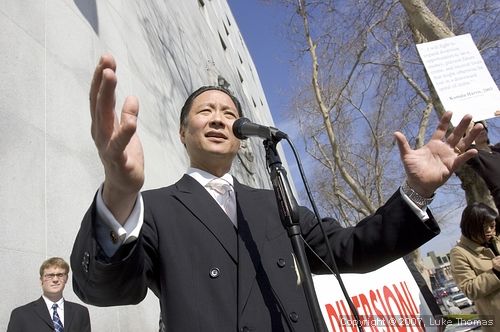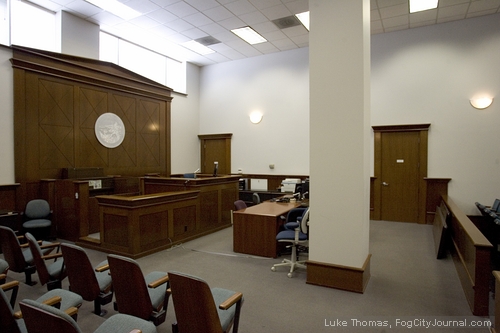
San Francisco Public Defender Jeff Adachi.
Photo by Luke Thomas
By Jeff Adachi, Special to Fog City Journal
Editor’s Note:Â An independent report and analysis of CJC efficacy is available here.
June 18, 2009
Now that it has been operational for three months, the Community Justice Center (CJC) should be evaluated based upon a factual and empirical analysis of objective data from the cases that have been heard in the court. With the upcoming budget hearings focusing on the city’s dire financial situation, there will no doubt be a discussion as to whether the court is on the road to fulfilling its promise, or whether the money spent on this court could be better invested elsewhere.
It is important at the outset, to separate the discussion of funding for the court from the operations and outcomes of the court. The question of whether the cost of the court is justified should be viewed independently from the question of whether the court is doing what was promised.  Whether the court is producing its intended outcomes is a separate issue from what it costs to operate, or whether the money could be put to better uses. There will always be other competing uses of funds and it is unfair to compare uses that have different objectives or outcomes from that of the court.
Before there can be an honest debate, there must be accurate information upon which to rely upon, to assess the legal and social outcomes realized by the court. While anecdotes may be informative, they rely largely on the party reporting the event.
For example, one might say, “I saw a person who received services from the court who was able to really turn their life around, and I could tell that she was happy and wanted to be there.” This may be true or it may not be — it is simply the subjective opinion of the person reporting the event. What is more telling is whether the specific legal and social outcomes that were set for the individual were met, and whether the resulting change in behavior affected the community.
According to the original needs assessment, completed in 2008, which set for the plan for the CJC, the purpose of the court was to address problems such as “drug dealing, aggressive panhandling, graffiti, prostitution and public urination.”  The court’s representatives promised that it would be a change-agent in the Tenderloin, which has long been perceived a containment zone for crime. A community poll revealed that the top complaint involved “drug dealing, and drug and alcohol abuse.” The court was to provide “leadership and a coherent approach to coordination of service delivery … within the justice system.”
The concept was simple: a host of services would be offered on-site to persons who needed or wanted services through the court. These services were to include drug treatment, mental health programs, support groups, counseling, career development and job training.
I began staffing the court myself when it opened in March 2009 and am familiar with its operations. In the spirit of providing an accurate and evidence-based evaluation of the court’s first three months in operation, I offer a number of informational points for the discussion that may follow.
1) What type of case is being heard at the CJC?
The types and numbers of cases are easily determined by listing the case by its case type, and the number of these cases heard at the court. This will provide information about the type of cases that are being referred to the CJC, and the type of cases that are not being referred there. Based on the cases I have seen at the CJC, the case types include the following categories:
a.    Public nuisance – Penal Code 372
b.    Obstructing the sidewalk – MPC 22(a)
c.     Lodging – Penal Code 647(e)
d.    Possession of paraphernalia – Health and Safety Code 11364 HS/M
e.     Petty Theft – Penal Code 484
f.      Possession of narcotics – Health and Safety Code 11350a HS/F
g.     Under the influence of a narcotic – Health and Safety Code 11550 HS/M
h.     Marijuana possession – Health and Safety Code 11357
i.       Possession with intent to sell – Health and Safety Code 11351
j.       Drug Sales – Health and Safety Code 11352a
k.     Assault & Battery – Penal Code section 32
l.       Vehicle code infractions
m.     Miscellaneous crimes
To avoid confusion, since some cases have multiple charges, each charge must be counted. There should also be a separate count as to the number of cases.
2) What are the legal outcomes of these cases?
The term “legal outcome” refers to the disposition in court on a particular case. There are a number of legal outcomes that commonly occur:
a.   Discharged cases (cases which appear on the court calendar but are not charged)
b.   Bench warrant (case is filed but the accused fails to appear)
c.    Dismissed/pending after performing community service through the CJC
d.   Dismissed/pending after referral to pretrial diversion program
e.    Dismissed/pending after referral to drug diversion program
f.     Dismissed/pending after referral to a drug program
g.    Court date rescheduled
h.    Continued on probation
i.     Case resolved through guilty plea
“Pretrial diversion” is a program that is operated by San Francisco Pretrial Diversion Project, Inc., a long-time non-profit organization that handles cases at the Hall of Justice. Established by statute many years ago, the Pretrial Diversion program provides community service opportunities for first time offenders. Pretrial diversion is not available at the CJC per se; however, the court has used pretrial diversion as a means to dismiss cases when a person has agreed to perform community service at the CJC.
Drug Diversion is a program operated by the Adult Probation Department. Participants agree to engage in drug treatment and receive a dismissal if they successfully complete a program, which usually lasts six months. Drug Diversion is a program available at the Hall of Justice. It is not available at the Community Justice Center, but again, the court has used drug diversion as a means to dismiss cases when a person has agreed to participate in drug treatment.
Additionally, there should be a separate accounting of cases of people who did not appear for the court and the number of people who did appear. There should be an accounting of the people who appeared at the CJC to receive services but did not have a pending case.
3) What are the social outcomes of these cases?
‘Social outcome’ refers the outcomes that the participant achieves as a result of participating in the CJC. Social outcomes include community service, mental health treatment, etc. Social outcomes do not include the assessment process. The number of clients assessed can be accounted for individually; there should be one assessment counted per case. Social outcomes include:
a.    Mental health treatment at the CJC
b.    Shelter bed through the CJC
c.     Drug treatment through the CJC
d.    Social security eligibility obtained through CJC
e.     Referrals to outside agencies for services
f.      Referrals to AA/NA
g.    Return to the Hall of Justice (when a case-type is rejected by the CJC or client otherwise deemed not to be an appropriate candidate for the court)
4) Are the social outcomes meeting the overall objective of the court, and how do they impact the community differently than a case outcome at the Hall of Justice?
This would involve an analysis of the social outcomes to determine which of the outcomes could be achieved at the Hall of Justice and which are unique to the CJC.
5) Are the legal outcomes meeting the overall objective of the court, and are the outcomes different than a case outcome for a similar case-type at the Hall of Justice?
This would involve a comparison of the legal outcome to determine which of the outcomes could be achieved at the Hall of Justice and which outcomes were unique to the CJC.
The final two questions involve the cost of the court. As noted above, these questions should be analyzed separately from questions 1-5, which relate to the case and social outcomes.
6) How much is the CJC costing the city, and how are the resources being used? A related question is: How much is being spent by the state and federal government on the CJC?
I have not seen a budget for the CJC as of yet. However, as far as I can tell, there are four types of costs that are attributable to the CJC:
a.   City personnel charged to the operation of the CJC that is being funded through the city’s general fund or grant sources
b.   Court personnel charged to the operation of the CJC that is being funded through the Superior Court
c.    City personnel that is not being funded through any CJC monies but are being used to staff the court’s operations
d.    Court personnel that is not being funded through any CJC monies but are being used to staff the court’s operations
e.    Construction, overhead, and operational expenses funded by the city
f.     Construction, overhead and operational expenses funded by the state
g.    Lease, construction, overhead and operational expenses funded by the federal government
These categories draw a distinction between costs accrued by the Superior Court and costs charged to the City and County. It should be noted that the Superior Court receives state funding and funding from the city. Some departments receive funding from multiple sources. For example, according to the Mayor’s budget analyst, the Sheriff is allotted five deputy positions at an annual cost of $515,000 to staff the CJC. However, the Sheriff is also allotted two additional deputies through the Superior Court (cost unknown). Thus, the Sheriff has a total of 7 positions allotted to its department through the CJC.   I also understand that a new holding cells will be built at the courthouse at a cost of $700,000. I believe $200,000 has already been spent, though no construction has begun yet.

Two holding cells adjacent to this CJC courtroom are slated for construction
at a cost of $700,000.
7) Could these resources be used in a more efficient and effective way to obtain the outcomes sought by the CJC?
This is the question, I believe, that will be at the heart of the budget discussions. While the outcomes of the CJC are laudable, the debate should focus on whether those outcomes are being met.
An independent researcher named Melissa Sills volunteered to do a study of the available data from the Public Defender’s office for the CJC cases we have handled to date. This report answers many, although not all, of the questions above.  Questions 1-5 are analyzed according to the available data. Note that while the Public Defender’s office handles the bulk of the cases at the CJC, there is only limited data for those cases handled by private attorneys since we do not maintain those files.  However, those cases are included in the case count to give a complete accounting of all of the cases heard at the CJC.
Ms. Sills did not attempt to analyze information concerning the cost-efficiencies, since we did not have access to the CJC budget or other financial information about how much is being spent at the CJC. I have requested a budget for the CJC from the Mayor’s budget office, but have not received one to date.
I have shared this with the staff of the CJC and other interested stakeholders in the spirit of working towards an objective and straightforward review of the operations of the court. I will hold my opinions for the time being and let Ms. Sills’ report speak for itself.


 The Hunger Site
The Hunger Site
June 19, 2009 at 6:30 pm
RUN JEFF RUN